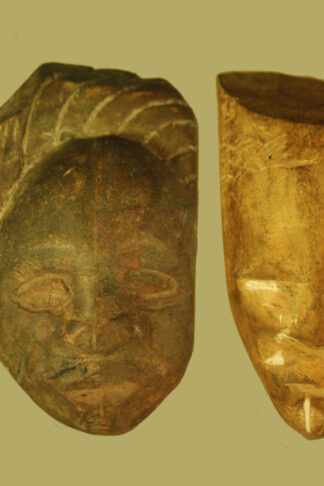Description
History behind the mask
This ritual mask is an adaptation of a traditional Baule face mask used for ceremonial dances. The portrayed beautiful women and heroic men promote the Baule ideas of ideal beauty and values.
The Baule people are one of the largest ethnic groups in Côte d’Ivoire. They belong to the Akan people who lived in Ghana centuries ago. According to a legend, the queen mother, Abla Pokou, had to lead her people west to the banks of the Comoe in the 18th century to flee from the Ashanti. To cross the river, she sacrificed her own son. This sacrifice was the origin of the name Baule, because Baouli means “the child died”.
The Baule are known as farmers and the importance of the yam is reflected in an annual harvest festival where the first yam is symbolically sacrificed to the ancestors, whose worship is an important aspect of the Baule religion.
The basis of Baule social and political institutions is matrilineality; each lineage has ceremonial chairs that embody the spirits of the ancestors.
The Baule are known for their fine wooden sculptures and exceptional craftsmanship, especially their ritual statuettes representing spirits. These, as well as carved ceremonial masks, were originally related to ancestor worship, but are increasingly produced for commercial purposes.
For the Baule, sculpture has many functions that can change over time and in different contexts.
Mblo masks embody the central style of Baule sculpture. Characteristic of portrait masks are an oval face with a long nose, a small, open mouth, downturned, slit eyes with prominent parts that protrude beyond the vertex and resemble animal horns. Shiny, curved surfaces suggesting clean, healthy and well-fed skin are interrupted by finely textured zones representing hairstyles, scarification and other ornaments. The idealised faces are introverted. The ornaments above the face – birds, combs, horns, faces and other decorative motifs – are chosen for their beauty and have no iconographic significance. The triangular additions of brass enhance the shiny patina as it dances in the sunlight, an indication of health.
In the Baule communities, the Mblo dances culminate in a performance that honours the most admired member of the community. This is represented by a mask designed as their artistic “double” or “namesake”.
While such works can represent either men or women, they were often commissioned by a man to honour a female relative, or created by a carver as a tribute to the dancing skills and beauty of a particular woman. Because of their importance, only the best dancers are entitled to wear portrait masks at performances. On such occasions, the presence of the sitter or ‘double’ is required to accompany him or her.
In an Mblo mask, a masquerader in a cloth costume covers his face with a small wooden mask and dances for an audience accompanied by drummers, singers, dancers and speakers in a series of skits. When not in use, the Gbagba masks are kept out of sight, so it is unusual for us to see a mask in this way.











Reviews
There are no reviews yet.